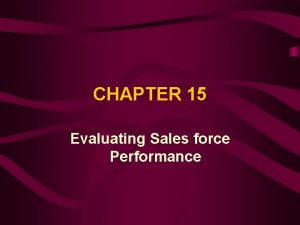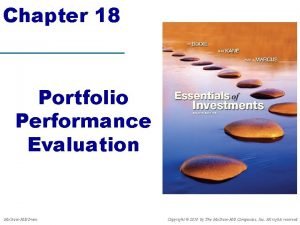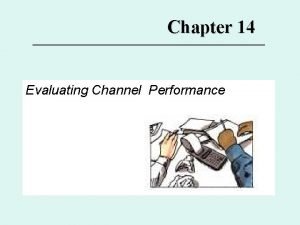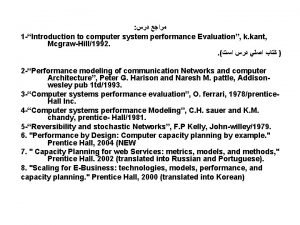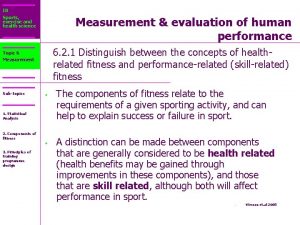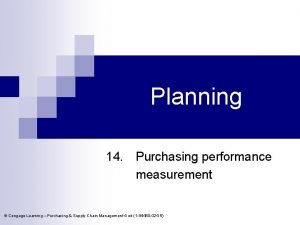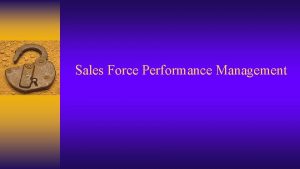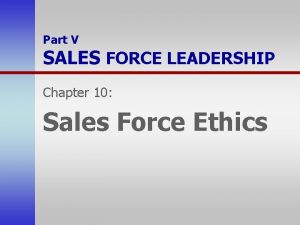Chapter 14 Sales Force Performance Evaluation Chapter Outline





















- Slides: 21

Chapter 14 Sales Force Performance Evaluation

Chapter Outline • Sales Force Performance Appraisal • A Contemporary Approach to Sales Force Performance Evaluation • Providing Feedback and Improving Sales Force Performance • Emerging Perspectives in Twenty-First Century Sales Force Performance Appraisals Copyright © Houghton Mifflin Harcourt Publishing Company. All rights reserved. 14 | 2

Sales Force Performance Appraisal • A salesperson performance appraisal is a systematic process for establishing whether the salesperson’s job behavior contributes to the fulfillment of a firm’s sales objectives and for providing specific feedback to the individual. Copyright © Houghton Mifflin Harcourt Publishing Company. All rights reserved. 14 | 3

Sales Force Performance Appraisal • Performance appraisals can help managers accomplish the following: – increase/decrease compensation and awards to high/low performers – identify training needs of salespeople – mentor salespeople about their careers – revise sales performance and evaluation process – develop a top notch sales team Copyright © Houghton Mifflin Harcourt Publishing Company. All rights reserved. 14 | 4

Challenges in Salesperson Performance Appraisals • Evaluating salespeople is challenging because they encounter the following hurdles: – mostly work alone in the field – engage in a multitude of activities – have differences in territory potentials – have physical disparities in their territories – face intense, varying competition – have to allocate their time between account development and account maintenance – need sufficient time to adjust to their assigned territories Source: © Jack Hollingsworth/Corbis Copyright © Houghton Mifflin Harcourt Publishing Company. All rights reserved. 14 | 5

Timing of Salesperson Performance Appraisals • Performance appraisals are usually conducted over these intervals: – once a year – sometimes semiannually – sometimes quarterly • Evaluations include two kinds of criteria: – objective (quantitative) criteria – subjective (qualitative) measures Copyright © Houghton Mifflin Harcourt Publishing Company. All rights reserved. Source: © Jack Hollingsworth/Corbis 14 | 6

A Contemporary Approach to Sales Force Performance Evaluation Establish sales goals and objectives. Develop the sales plan. Set sales force performance standards. Allocate resources and sales force efforts. Measure sales force performance against standards. Copyright © Houghton Mifflin Harcourt Publishing Company. All rights reserved. Take corrective action. 14 | 7

Establish Sales Goals and Objectives • Formulate sales goals, such as these: Source: Flying Colours Ltd Copyright © Houghton Mifflin Harcourt Publishing Company. All rights reserved. – increasing sales by 5 percent each year over the next five years – increasing market share by 4 percent by the next five years – reducing customer defections by 12 percent – increasing the new customer base by 10 percent each year 14 | 8

Develop the Sales Plan “How much progress are we making toward our destination? ” • set standards of performance • evaluate actual performance versus planned standards • take corrective action on variances from plan 3. Action programs “What’s the best way to get there? ” • strategies and tactics 4. Performance evaluation systems Sales Plan 2. Opportunities and problems Copyright © Houghton Mifflin Harcourt Publishing Company. All rights reserved. “Where are we now? ” • market situation and competitive environment • product sales situation 1. Situation analysis “Where do we want to go? ” • internal environment • external environment • planning assumptions and constraints • sales forecasts • contingency planning 14 | 9

Sales Force Performance Evaluation Copyright © Houghton Mifflin Harcourt Publishing Company. All rights reserved. 14 | 10

Types of Sales Quotas Copyright © Houghton Mifflin Harcourt Publishing Company. All rights reserved. 14 | 11

Administration of Sales Quotas 1. Set realistic quotas. 5. Maintain control (performance evaluation). Administration of sales quotas 4. Keep the sales force updated. Copyright © Houghton Mifflin Harcourt Publishing Company. All rights reserved. 2. Create understandable quotas. 3. Include salespeople in quota setting. 14 | 12

Performance Monitoring Systems 1. 3. Performance review: Performance planning Conduct overall performance evaluation. “Where am I going? ” “How will I get there? ” “How will I be measured? ” Performance evaluation monitoring system stages 2. Performance appraisal Provide immediate feedback (praise, or correction) on each task accomplished. Copyright © Houghton Mifflin Harcourt Publishing Company. All rights reserved. 14 | 13

Types of Performance Appraisal Techniques 4. Management by objectives 3. Behaviorally anchored rating scales Types of performance appraisal techniques 1. Descriptive statements 2. Graphic rating scales Copyright © Houghton Mifflin Harcourt Publishing Company. All rights reserved. 14 | 14

Graphic Rating Scales Semantic differential graphic rating scale product knowledge poor ___ ___ ___ _X_ ___ excellent 1 2 3 4 5 6 7 Likert-type graphic rating scale product knowledge _______ ___X__ unsatisfactory below average Copyright © Houghton Mifflin Harcourt Publishing Company. All rights reserved. __________ above outstanding average 14 | 15

Behaviorally Anchored Rating Scales Cooperation with sales team members Categories of performance Observed behavior 10 Very high indicates strong willingness to cooperate with other members of the sales team Moderate indicates an average amount of cooperation with other team members 8 Salesperson will always cooperate in any way with other sales force team members, even if such effort is personally inconvenient or requires self-sacrifice. 7 Salesperson can be expected to go out of his 9 6 Salesperson is usually willing to help other 5 team members on field sales problems. 4 Salesperson will occasionally help team 3 Very low indicates generally no team effort, which often hurts group performance or her way to help other team members with any work-related problem. 2 members with field sales problems Salesperson seldom helps others and tends to resent contributing to group effort. 1 0 Copyright © Houghton Mifflin Harcourt Publishing Company. All rights reserved. Salesperson is generally antagonistic toward other team members and frequently undercuts group efforts. 14 | 16

Limitations of Sales Force Evaluation Systems • • • Source: Stockbyte political concerns fear of reprisal varying evaluation standards interpersonal bias questionable personality traits organization use recency bias no outcome focus inadequate sampling of job activities • similar-to-me error • first-impression error • leniency or harshness error Copyright © Houghton Mifflin Harcourt Publishing Company. All rights reserved. 14 | 17

Emerging Perspectives in Twenty-first Century Sales Force Performance Appraisals: 360 -Degree Performance Evaluation Sales manager Other departmental coworkers Purchasing managers (clients) 360 -degree salesperson performance appraisal Accounts payable managers Sales team peers External customers Internal customers Sales subordinates Selfappraisal Copyright © Houghton Mifflin Harcourt Publishing Company. All rights reserved. 14 | 18

Sales Force Performance Appraisals: Performance Evaluations of Team Selling • In cooperation, sales managers and sales force team members select relevant performance criteria and appraisal methods. • Each team member rates all the other members on the following: Source: Stockbyte Copyright © Houghton Mifflin Harcourt Publishing Company. All rights reserved. – – teamwork leadership productivity team relations 14 | 19

Emerging Perspectives In Twenty-First Century Sales Force Performance Appraisals: Performance Review Ranking System • Evaluate salespeople on performance using a scale, such as this: – A = excellent – B = above average – C = average – D = satisfactory performance – E = sub-par performance • Then rank each salesperson and place them in performance categories: – top 20 percent – middle 70 percent – bottom 10 percent Source: Stockbyte • Move out the bottom performers with new talent, thus creating meritocracies. Copyright © Houghton Mifflin Harcourt Publishing Company. All rights reserved. 14 | 20

Ethical Situation: What Would You Do? Discussion Question You are one of six regional sales managers for a large manufacturer of consumer products. About ten district sales managers report to each one of the regional sales managers. This year, your national sales manager is requiring all the company’s sales managers to use a Likert-type performance evaluation scale to rate each of their subordinates on various dimensions. The evaluation scale has five performance blocks or segments labeled: outstanding, above average, below average, and poor. Knowing that these evaluations will be used for current raises and bonuses, and promotions over the longer run, you plan to rate all the district sales managers reporting to you as at least “above average” and some “outstanding. ” In all honesty, you know that four of your district managers should be rated no better than “average, ” but you don’t want to hurt their chances for raises, bonuses, and promotion, so you just don’t use the bottom three segments of the evaluation scale. By rating your people higher than they should be, you feel that you retain their loyalty and support while keeping morale higher than it would be if your performance evaluations were more accurate. You rationalize this evaluation approach to yourself by asking: “Who gets hurt if I rate my people on the high side? Other regional sales managers probably do the same thing. ” Copyright © Houghton Mifflin Harcourt Publishing Company. All rights reserved. 14 | 21
 Evaluating sales performance
Evaluating sales performance Sales force structure adalah
Sales force structure adalah Incremental method of sales force example
Incremental method of sales force example Controlling the sales force is an activity of
Controlling the sales force is an activity of Evaluating sales force performance
Evaluating sales force performance Discuss the nuances of sales letters.
Discuss the nuances of sales letters. Sales force composite
Sales force composite Sales quotas and territories
Sales quotas and territories Mgc7
Mgc7 Quotation sandwiches
Quotation sandwiches Sales performance management framework
Sales performance management framework Computer architecture performance evaluation methods
Computer architecture performance evaluation methods Portfolio performance evaluation problems
Portfolio performance evaluation problems Channel member performance audits
Channel member performance audits Progress and performance measurement and evaluation
Progress and performance measurement and evaluation Evaluation of computer system
Evaluation of computer system Pes manual usmc 2021
Pes manual usmc 2021 Measurement and evaluation in human performance 5e download
Measurement and evaluation in human performance 5e download Direct support professional performance evaluation
Direct support professional performance evaluation Performance evaluation for decentralized operations
Performance evaluation for decentralized operations How to measure standing vertical jump
How to measure standing vertical jump Purchasing performance evaluation
Purchasing performance evaluation




